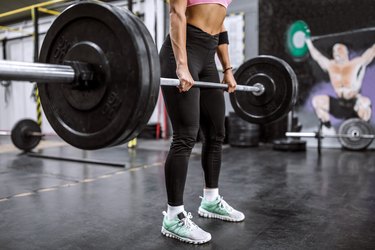
Strength training doesn't burn massive calories, but it helps build muscle and raises your metabolism. If your goal is to get leaner, focus on the best compound exercises for fat loss. Add circuits to the mix and crank up the intensity to maximize your fat-burning potential.
Tip
Squats, deadlifts, lunges and other compound movements increase post-exercise oxygen consumption and build lean mass. As a result, you'll continue to burn calories after leaving the gym and ignite your metabolism.
Video of the Day
Torch Fat With Strength Training
Tired of endless cardio workouts? Then it's time for a change! While it's true that cardio burns a lot of calories, strength training can be just as effective.
Video of the Day
Weight lifting promotes hypertrophy, or muscle growth. The more lean mass you have, the more calories you burn. According to the University of New Mexico, muscle tissue accounts for about 20 percent of total daily energy expenditure. Body fat, by comparison, accounts for only 5 percent of the total energy burned. It's estimated that each pound of muscle burns approximately 7 calories per day.
Strength training can help you burn anywhere between 90 and 133 calories in 30 minutes, depending on your weight, states Harvard Health Publishing. However, you'll continue to burn calories after leaving the gym due to the so-called afterburn effect, or EPOC (excess post-exercise oxygen consumption), explains the University of New Mexico.
As the researchers note, your body requires more energy after strength training to repair damaged tissues than it does after cardiovascular training. This increases the amount of oxygen consumed post-workout, leading to a higher calorie burn. The more intense your workout is, the greater the rate of EPOC.
Lifts That Burn the Most Calories
When it comes to fat loss, some exercises are better than others. Compound movements, such as squats, deadlifts, lunges and military presses, allow you to lift heavier weights and engage more muscle groups than isolation work. As a result, they elicit a higher EPOC effect than biceps curls, for example.
As the American Council on Exercise points out, both heavy lifting and circuit training increase EPOC levels. The key is to keep your rest periods short between sets.
High-intensity interval training, or HIIT, is even more effective. Over time, it may help improve your fat-to-muscle ratio, blood lipids and overall fitness in as little as three months, reports a small study published in the Journal of Exercise Rehabilitation in February 2018.
So if you're looking for workouts that burn the most calories, combine strength training with HIIT and full-body circuits. Prioritize compound movements to get the most out of your workout. Barbell back squats, front squats, walking lunges, chest presses, shoulder presses and deadlifts are all a great choice. Pull-ups, push-ups, chin-ups and other body-weight exercises fall into this category too.
Compound exercises not only build mass but also raise your heart rate and may improve cardiovascular fitness, states the American Council on Exercise. At the same time, they may help increase your range of motion and joint flexibility.
Add Circuits to the Mix
As discussed earlier, HIIT and circuit training increase EPOC and torch massive calories. The best part is, you can apply these methods when lifting weights. For example, you can do three sets of goblet squats followed by three sets of push-ups and three sets of renegade rows, pause briefly and start all over. That's a full-body circuit that works your arms, back, shoulders, chest legs, glutes and core muscles.
Other workouts that burn the most calories are those performed at high intensity. That's where HIIT comes in. For instance, you can do 30 seconds of Bulgarian split squats followed by 30 seconds of rest. Switch legs and repeat. As you progress, alternate between squat variations, kettlebell swings, push-ups, step-ups and other strength or body-weight exercises.
The afterburn effect depends on the intensity, not the duration of your workout, reports the American Council on Exercise. Therefore, you don't have to spend more time in the gym to burn fat. Keep your workouts short and intense and mix up your routine to prevent plateaus. Start with light weights, increasing the load and intensity as you progress.
- University of New Mexico: "Controversies in Metabolism"
- Harvard Health Publishing: "Calories Burned in 30 Minutes for People of Three Different Weights"
- University of New Mexico: "Metabolic Effects of Resistance Training"
- American Council on Exercise: "7 Things to Know About Excess Post-Exercise Oxygen Consumption (EPOC)"
- Journal of Exercise Rehabilitation: "Impact of a 12-Week High-Intensity Interval Training Without Caloric Restriction on Body Composition and Lipid Profile in Sedentary Healthy Overweight/Obese Youth"
- American Council on Exercise: "5 Benefits of Compound Exercises"